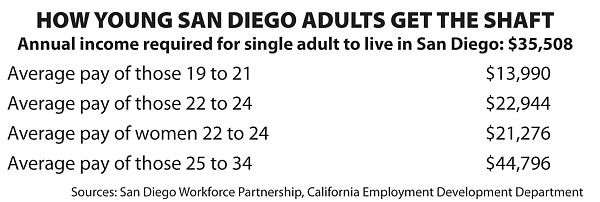 Facebook
Facebook
 X
X
 Instagram
Instagram
 TikTok
TikTok
 Youtube
Youtube

Youth is too beautiful to be wasted on the young. That may have been true in the 19th Century, but in 21st-century San Diego — and elsewhere — being youthful is no longer so beautiful, at least from an economic standpoint. The recession hit young adults harder than other age groups, and they have gained back less ground than older generations in the recovery.

According to the organization Generation Opportunity, the national unemployment rate for people 18 to 29 years of age is 13.1 percent, well above the overall rate. San Diego’s equivalent rate would probably be a bit higher, says Kelly Cunningham, economist for the National University System Institute for Policy Research. Reason: the San Diego economy is weaker than the national economy.

Vince Vasquez, senior policy analyst at the same institute, says that the unemployment rate for San Diego military veterans 18 to 34 years of age is 13.4 percent. But the rate is only 8.1 percent for the next-older cohort, veterans 35 to 54.
Many of today’s millennial generation (ages 18 to 29) have recently entered the job market. Strike one. “Research has shown that workers who enter the labor market during a recession can see long-term negative effects on their employment and earnings,” according to the United States Bureau of Labor Statistics. A Pew Research study last year showed that almost half of people age 18 to 34 took a job they didn’t want so they could pay their bills. Because of the weak economy, more than one-third have gone back to school and almost one-third have postponed getting married or having a baby.
In 1998, fully 65 percent of 18- to 34-year-olds were certain they could get another job if they lost their current post. That plunged to 27 percent in recessionary 2009. It has since bounced back to 43 percent, but that’s a long way from the 1998 level. Early this month, the American Psychological Association released a study indicating that Americans age 18 to 33 are the most stressed-out of any age group. On a 10-point scale, those in that younger generation reported an average stress level of 5.4, compared to the national average of 4.9. Almost 40 percent said their stress levels increased over the past year.
San Diegans of all ages have long lived in an economic squeeze: the cost of living is one of the highest in the nation, but incomes are only moderately higher than those in other metro areas.


“It is no secret that it costs a lot to live in San Diego,” says Margie de Ruyter, senior director of workforce initiatives for the San Diego Workforce Partnership. Data from the partnership tell the story: basic monthly living expenses for a single adult in San Diego County come to $2959; that requires a salary of $35,508 a year.
But look at what average young adults make in the county, according to California Employment Development Department data: The average pay of 14- to 18-year-old people in the county in the fourth quarter of 2011 was $12,576.
For 19- to 21-year-olds, the average yearly pay was $13,990, and the average new hire made $12,828. For 22- to 24-year-olds (including college grads), the average annual wage was $22,944 and the average new hire made $21,888. For those 25 to 34 years old, the yearly wage rose to $44,796, but the average new hire was paid only $36,156.
Not surprisingly, women suffer pay discrimination. For females 22 to 24 in the fourth quarter of 2011, the average annual pay was $21,276, and for new hires, $20,280. In the 25–34 cohort, the average annual pay was $39,516 and for new hires $32,964, or below the minimum requirement for a single adult.
“Few households live off one income,” says Cunningham. Living in this squeeze “takes multiple workers per household, doubling up in housing and often working multiple jobs, full-time as well as part-time. This is particularly true for young people, considering how expensive housing is.” Housing prices have come down 35 percent from pre–Great Recession peaks, “but rents went up.” According to Zillow.com, the median home value in the San Diego County market is $381,900, which is fourth highest among the 30 largest metro areas, and well over double the nation’s $157,400 median. The median rent is $2101 per month, fourth highest among the 30 largest markets and far above the nation’s $1274.
“Teen homelessness is on the rise; more young people are couch-surfing or sleeping at friends’ places,” says de Ruyter.
Older, experienced people are forced to delay or cancel retirement “and take jobs below what they were making before; because they have more experience, they push out young people,” says Cunningham. San Diego is suffering from out-migration, and among those leaving for cheaper areas are the young adults. Similarly, the squeeze on San Diego’s millennial generation inhibits young people from moving here from elsewhere. “Think of those young people with a college degree in liberal arts, saddled with debt, working at a Starbucks.”
The fact that young couples need two incomes inhibits birth of babies; San Diego’s natural population increase (births minus deaths) declines, according to Cunningham’s figures.
In San Diego, remedial steps are being taken. The San Diego Workforce Partnership administers federal job-training funds and raises money elsewhere. The organization trains young low-income people, “foster youth or those transitioning out of foster care, youth with disabilities, gang-affiliated, high school dropouts,” says de Ruyter. The partnership’s job is to help such people with employment. The partnership got $200,000 from City government sources. The money will be used for a youth-hiring program that includes high school dropouts as well as grads, and even some at the college level.
Vasquez, of the National University System Institute for Policy Research, is spearheading, along with a friend, the Military Veteran Scholarship Fund at the University of California San Diego. The group aims to raise $25,000 that will be matched by university alumni.
There is good news. The Social Science Research Council did a study on what percentage of those 16 to 24 were neither working nor in school. They are named “the disconnected.” Among 25 metro areas, San Diego had the third-lowest percentage of disconnected (11.1), including the lowest percentage of disconnected African-Americans (12.1) and second lowest of Latinos (13.3).


Youth is too beautiful to be wasted on the young. That may have been true in the 19th Century, but in 21st-century San Diego — and elsewhere — being youthful is no longer so beautiful, at least from an economic standpoint. The recession hit young adults harder than other age groups, and they have gained back less ground than older generations in the recovery.

According to the organization Generation Opportunity, the national unemployment rate for people 18 to 29 years of age is 13.1 percent, well above the overall rate. San Diego’s equivalent rate would probably be a bit higher, says Kelly Cunningham, economist for the National University System Institute for Policy Research. Reason: the San Diego economy is weaker than the national economy.

Vince Vasquez, senior policy analyst at the same institute, says that the unemployment rate for San Diego military veterans 18 to 34 years of age is 13.4 percent. But the rate is only 8.1 percent for the next-older cohort, veterans 35 to 54.
Many of today’s millennial generation (ages 18 to 29) have recently entered the job market. Strike one. “Research has shown that workers who enter the labor market during a recession can see long-term negative effects on their employment and earnings,” according to the United States Bureau of Labor Statistics. A Pew Research study last year showed that almost half of people age 18 to 34 took a job they didn’t want so they could pay their bills. Because of the weak economy, more than one-third have gone back to school and almost one-third have postponed getting married or having a baby.
In 1998, fully 65 percent of 18- to 34-year-olds were certain they could get another job if they lost their current post. That plunged to 27 percent in recessionary 2009. It has since bounced back to 43 percent, but that’s a long way from the 1998 level. Early this month, the American Psychological Association released a study indicating that Americans age 18 to 33 are the most stressed-out of any age group. On a 10-point scale, those in that younger generation reported an average stress level of 5.4, compared to the national average of 4.9. Almost 40 percent said their stress levels increased over the past year.
San Diegans of all ages have long lived in an economic squeeze: the cost of living is one of the highest in the nation, but incomes are only moderately higher than those in other metro areas.


“It is no secret that it costs a lot to live in San Diego,” says Margie de Ruyter, senior director of workforce initiatives for the San Diego Workforce Partnership. Data from the partnership tell the story: basic monthly living expenses for a single adult in San Diego County come to $2959; that requires a salary of $35,508 a year.
But look at what average young adults make in the county, according to California Employment Development Department data: The average pay of 14- to 18-year-old people in the county in the fourth quarter of 2011 was $12,576.
For 19- to 21-year-olds, the average yearly pay was $13,990, and the average new hire made $12,828. For 22- to 24-year-olds (including college grads), the average annual wage was $22,944 and the average new hire made $21,888. For those 25 to 34 years old, the yearly wage rose to $44,796, but the average new hire was paid only $36,156.
Not surprisingly, women suffer pay discrimination. For females 22 to 24 in the fourth quarter of 2011, the average annual pay was $21,276, and for new hires, $20,280. In the 25–34 cohort, the average annual pay was $39,516 and for new hires $32,964, or below the minimum requirement for a single adult.
“Few households live off one income,” says Cunningham. Living in this squeeze “takes multiple workers per household, doubling up in housing and often working multiple jobs, full-time as well as part-time. This is particularly true for young people, considering how expensive housing is.” Housing prices have come down 35 percent from pre–Great Recession peaks, “but rents went up.” According to Zillow.com, the median home value in the San Diego County market is $381,900, which is fourth highest among the 30 largest metro areas, and well over double the nation’s $157,400 median. The median rent is $2101 per month, fourth highest among the 30 largest markets and far above the nation’s $1274.
“Teen homelessness is on the rise; more young people are couch-surfing or sleeping at friends’ places,” says de Ruyter.
Older, experienced people are forced to delay or cancel retirement “and take jobs below what they were making before; because they have more experience, they push out young people,” says Cunningham. San Diego is suffering from out-migration, and among those leaving for cheaper areas are the young adults. Similarly, the squeeze on San Diego’s millennial generation inhibits young people from moving here from elsewhere. “Think of those young people with a college degree in liberal arts, saddled with debt, working at a Starbucks.”
The fact that young couples need two incomes inhibits birth of babies; San Diego’s natural population increase (births minus deaths) declines, according to Cunningham’s figures.
In San Diego, remedial steps are being taken. The San Diego Workforce Partnership administers federal job-training funds and raises money elsewhere. The organization trains young low-income people, “foster youth or those transitioning out of foster care, youth with disabilities, gang-affiliated, high school dropouts,” says de Ruyter. The partnership’s job is to help such people with employment. The partnership got $200,000 from City government sources. The money will be used for a youth-hiring program that includes high school dropouts as well as grads, and even some at the college level.
Vasquez, of the National University System Institute for Policy Research, is spearheading, along with a friend, the Military Veteran Scholarship Fund at the University of California San Diego. The group aims to raise $25,000 that will be matched by university alumni.
There is good news. The Social Science Research Council did a study on what percentage of those 16 to 24 were neither working nor in school. They are named “the disconnected.” Among 25 metro areas, San Diego had the third-lowest percentage of disconnected (11.1), including the lowest percentage of disconnected African-Americans (12.1) and second lowest of Latinos (13.3).
Comments